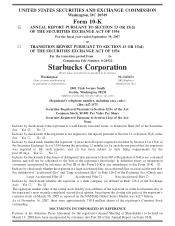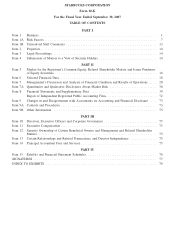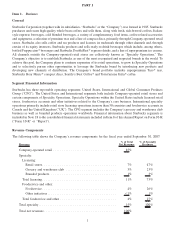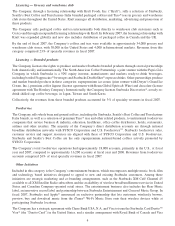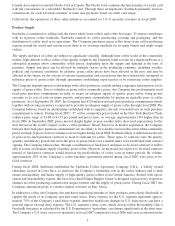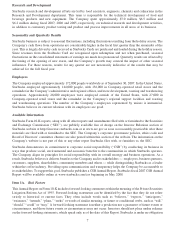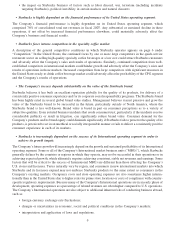Starbucks 2007 Annual Report Download - page 8
Download and view the complete annual report
Please find page 8 of the 2007 Starbucks annual report below. You can navigate through the pages in the report by either clicking on the pages listed below, or by using the keyword search tool below to find specific information within the annual report.fourth quarter of fiscal 2007 and have remained high, adversely affecting the U.S. segment’s and the Company’s
profitability. In the United States, the Company purchases substantially all of its fluid milk requirements from two
dairy suppliers. The Company believes, based on relationships established with these suppliers, that the risk of non-
delivery of enough fluid milk to support its U.S. retail business is remote.
The Company also purchases a broad range of paper and plastic products, such as cups, lids, cutlery, napkins,
straws, shopping bags and corrugated paper boxes from several companies to support the needs of its retail stores as
well as its manufacturing and distribution operations. The cost of these materials is dependent in part upon
commodity paper and plastic resin costs, but the Company believes it mitigates the effect of short-term raw material
price fluctuations through strategic relationships with key suppliers.
Products other than whole bean coffees and coffee beverages sold in Starbucks retail stores are obtained through a
number of different channels. Beverage ingredients, other than coffee and milk, including leaf teas and the
Company’s selection of ready-to-drink beverages, are purchased from several specialty manufacturers, usually
under long-term supply contracts. Food products, such as fresh pastries, breakfast sandwiches and lunch items, are
generally purchased from both regional and local sources. Coffee-making equipment, such as drip and coffee press
coffeemakers, espresso machines and coffee grinders, are generally purchased directly from their manufacturers.
Coffee-related accessories, including items bearing the Company’s logos and trademarks, are produced and
distributed through contracts with a number of different suppliers.
Competition
The Company’s primary competitors for coffee beverage sales are quick-service restaurants and specialty coffee
shops. In almost all markets in which the Company does business, there are numerous competitors in the specialty
coffee beverage business, and management expects this situation to continue. The Company believes that its
customers choose among retailers primarily on the basis of product quality, service and convenience, and, to a lesser
extent, on price. Starbucks has recently experienced significantly greater direct competition from large competitors
in the United States quick-service restaurant sector, some of whom have substantially greater financial, marketing
and operating resources than the Company. Starbucks also faces well-established competitors in many International
markets and increased competition in the U.S. ready-to-drink coffee beverage market.
The Company’s whole bean coffees compete directly against specialty coffees sold through supermarkets, specialty
retailers and a growing number of specialty coffee stores. Both the Company’s whole bean coffees and its coffee
beverages compete indirectly against all other coffees on the market. Starbucks Specialty Operations face
significant competition from established wholesale and mail order suppliers, some of whom have greater financial
and marketing resources than the Company.
Starbucks faces intense competition from both restaurants and other specialty retailers for prime retail locations and
qualified personnel to operate both new and existing stores.
Patents, Trademarks, Copyrights and Domain Names
The Company owns and/or has applied to register numerous trademarks and service marks in the United States and
in many additional countries throughout the world. Rights to the trademarks and service marks in the United States
are generally held by a wholly owned affiliate of the Company and are used by the Company under license. Some of
the Company’s trademarks, including Starbucks, the Starbucks logo, Frappuccino, Seattle’s Best Coffee and Tazo
are of material importance to the Company. The duration of trademark registrations varies from country to country.
However, trademarks are generally valid and may be renewed indefinitely as long as they are in use and/or their
registrations are properly maintained.
The Company owns numerous copyrights for items such as product packaging, promotional materials, in-store
graphics and training materials. The Company also holds patents on certain products, systems and designs. In
addition, the Company has registered and maintains numerous Internet domain names, including “Starbucks.com”
and “Starbucks.net.”
6

